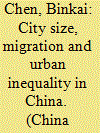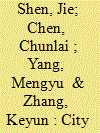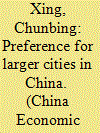| Srl | Item |
| 1 |
ID:
161870


|
|
|
|
|
| Summary/Abstract |
This paper examines the relationship between city size, migration, and urban income inequality using a subsample of the 1% population census of China in 2005. We calculate various measures of within-city income inequality for 252 Chinese cities. It is found that overall city income inequality is significantly and positively correlated with population size. As migration is crucial in determining city size distribution in China, we focus on exploring the role of massive migration into big cities in shaping this size-inequality relationship. We find that the share of migrants alone accounts for more than 40% of the city size inequality premium. This is primarily because migration leads to higher skill premiums in larger cities by changing the skill composition of workers in those places.
|
|
|
|
|
|
|
|
|
|
|
|
|
|
|
|
| 2 |
ID:
164723


|
|
|
|
|
| Summary/Abstract |
This paper investigates the impact of China's city size and urban population concentration on city productivity by developing a distinctive index based on global nighttime light data. Using the panel data of 280 prefecture cities from 2004 to 2013 and employing dynamic system generalized method of moments and panel threshold model regression techniques, our results show that city size has a positive impact on city productivity; therefore, cities in China still have the potential to expand. While moderate urban population concentration can benefit city productivity, excessively concentrated urban population distribution may impede the growth of city productivity. We also find that the level of labor income significantly affects the impacts of urban agglomeration on labor productivity. Therefore, our results imply that city development policies should focus more on how to appropriately allocate economic activities and adjust population distribution in urban areas according to different stages of economic development.
|
|
|
|
|
|
|
|
|
|
|
|
|
|
|
|
| 3 |
ID:
153055


|
|
|
|
|
| Summary/Abstract |
The spatial distribution of population and economic activities has important impacts on both economic growth and the environment. This paper uses a slack-based measure to estimate the total factor environmental efficiency (TFEE) of 286 Chinese prefectural-and-above cities for the period 2002–2013. In particular, the relationship between city size and TFEE is investigated. The findings also show an inverted U-shaped relationship between TFEE and city size, which implies an optimal city size of 16.68 million residents in China. According to this estimate, most Chinese cities may be undersized due to the migration restrictions of the hukou registration system and, hence, suffer from great environmental efficiency losses. The estimated low average TFEE value of Chinese cities also suggests the large potential for efficiency improvement. Thus, government policies should focus on relaxing migration restrictions and encouraging the development of large cities.
|
|
|
|
|
|
|
|
|
|
|
|
|
|
|
|
| 4 |
ID:
159033


|
|
|
|
|
| Summary/Abstract |
China has long aimed to restrict population growth in large cities but encourages growth in small and medium-sized cities. At the same time, various government policies favor large cities. We conjecture that larger cities in China offer a better quality of life and more opportunities. We thus predict that a typical rural-urban migrant is willing to give up some income in order to live in a larger city. We present a simple model in which rural-urban migrants choose destination cities to maximize utilities from consumption and urban amenities. Drawing data from a large-scale population survey conducted in 2005, we first estimate each migrant's expected earnings in each possible destination city using a semi-parametric method to correct for potential selection bias. We then estimate the typical migrant's preference for city population size, instrumenting population size with its lagged values to control for potential omitted-variables bias. From these estimation results, we calculate the typical migrant's willingness to pay to live in larger cities. Our results show that indeed rural-urban migrants strongly prefer cities with larger populations. We explore possible explanations for this preference and discuss the implications of these findings.
|
|
|
|
|
|
|
|
|
|
|
|
|
|
|
|